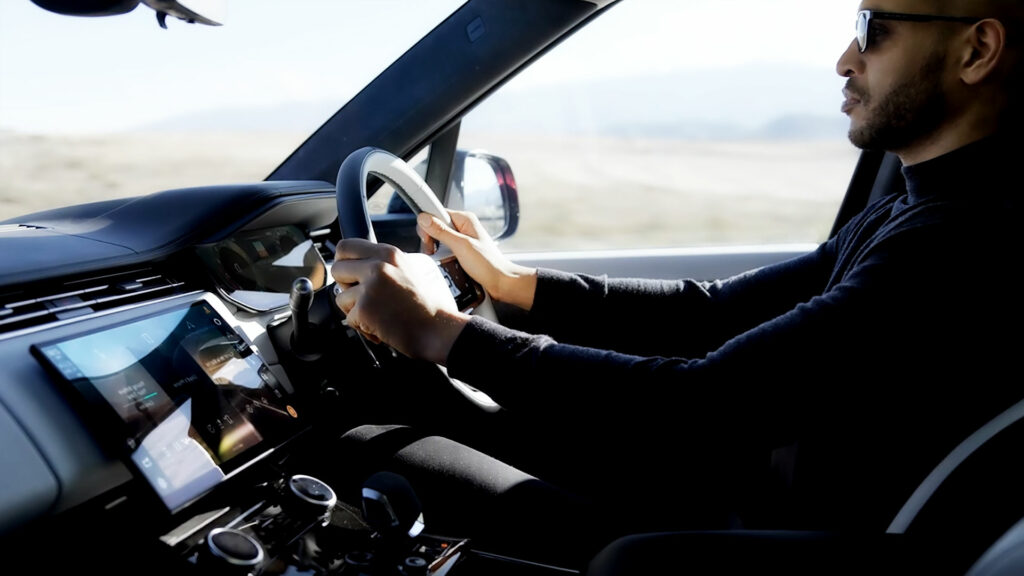Hot on the heels of Hyundai‘s announcement that it will be investing £15 billion to achieve a global number 3 position when it comes to overall EV market share, Jaguar Land Rover has announced a similar level of investment as the company evolves away from its petrol/diesel past, into an environmentally-friendly future of luxury driving. Seven years after the launch of the i-Pace, Jaguar customers will be able to drive away in a next-gen GT in early 2025, with at least two more models following closely behind. WhichEV saw the announcements first hand at Jaguar Land Rover's Gaydon facility.
In 2018, the i-Pace was one of the hottest properties in the EV landscape, with stylish good looks, plenty of power under the bonnet, decent range and an attractive familiarity built into the interior. After a long wait, JLR has now announced that the first of three reimagined modern luxury Jaguars will be a 4-door GT built in Solihull in the West Midlands – and the first deliveries will land in the UK in 2025, based on orders that will be taken toward the end of next year. According to JLR's presentation, the new EV will have the most powerful engine ever fitted in a production Jaguar – a record presently held by the Jaguar Project 8.
As WhichEV previously reported, the automaker’s Electromagnetic Compatibility (EMC) laboratory at Gaydon in the UK will ensure future vehicles meet current and future legislation as well as quality standards for connectivity and electronics.
Adrian Mardell, CEO, told media that the new GT will deliver around 600 hp and have a WLTP range of up to 430 miles. Combine those numbers with a street price of £100,000 and you have a serious competitor at the top end of the market. It will be built on a new architecture called JEA and more details on this 4-door GT Jaguar will be released later this year.
We can always expect stylish designs from JLR, but what about the company's underlying finances?
Mardell promised: “Investment of £15bn over five years in JLR’s industrial footprint, vehicle programmes, autonomous, AI and digital technologies and people skills”, also stating that: “JLR will become a double-digit profitable business by FY26, cash positive from FY25. In Q3, we achieved Revenue of £6bn, EBIT of 3.79%, Profit before Tax of £265m and generated cash of £490m. Our Q4 wholesales were up 19% vs Q3 excluding Chery – and up 24% vs Q422.”
“Free cash flow is estimated to be over £800 million positive for Q423, based on a preliminary estimated cash balance of over £3.7 billion and net debt of around £3.0 billion,” he added. “Our record order book is circa 200,000 units for our latest highly successful Range Rover, Rover Sport and Defender models.”
There is a strong emphasis on green credentials with this new investment, as Mardell explains: “By 2039, we will be a net carbon zero business and by the end of this decade we will have reduced Greenhouse Gas emissions across our manufacturing and operations by 46 percent for Scope 1 and 2 and by 54% across our vehicle emissions value chains.”
Alongside the much anticipated new Jaguar EVs, JLR will also have a fully electric Range Rover on sale before the end of this year. Nick Collins, Executive Director for Vehicle Programmes, said: “Electrification is a journey. We have built-in flexibility that allows us to behave and act with an agile mindset and deliver electrification in line with the markets. [Our designs] will allow differing battery technologies, so we can evolve and adapt to include solid-state later in the decade.”
The move from the i-Pace platform to the new one (EMA), will see energy efficiency increase from 85% to 92%. This will be useful when you're trying to achieve long-range driving in a heavier car. JLR is looking to improve individual components and its complete supply chain, for every aspect of the company's next-gen EV production.
Barbara Bergmeier, Executive Director for Industrial Operations, told media:, “We are taking control of our own BEV value chain – by designing and manufacturing parts such as Electric Drive Units in-house. We are benefitting from the power of our Tata owners to accelerate our transformation.”
She continued: “We have a clear vision of a state-of-the-art Industrial Operation Ecosystem that is digitally enabled to deliver end-to-end visibility throughout the supply chain by 2026. We have developed a robust long-term strategy to ensure security of supply for the future. By the middle of the decade, we will need an estimated 6-10 giga-watt hours of battery cells. By 2030, we forecast that number will globally jump to at least 50 giga-watt hours.”
While Hyundai's investment of £15 billion has a really specific market share achievement in mind, this investment from JLR has been positioned as being more about defining the company's future DNA – and to be in position to offer truly desirable, unique electric products in the future.
